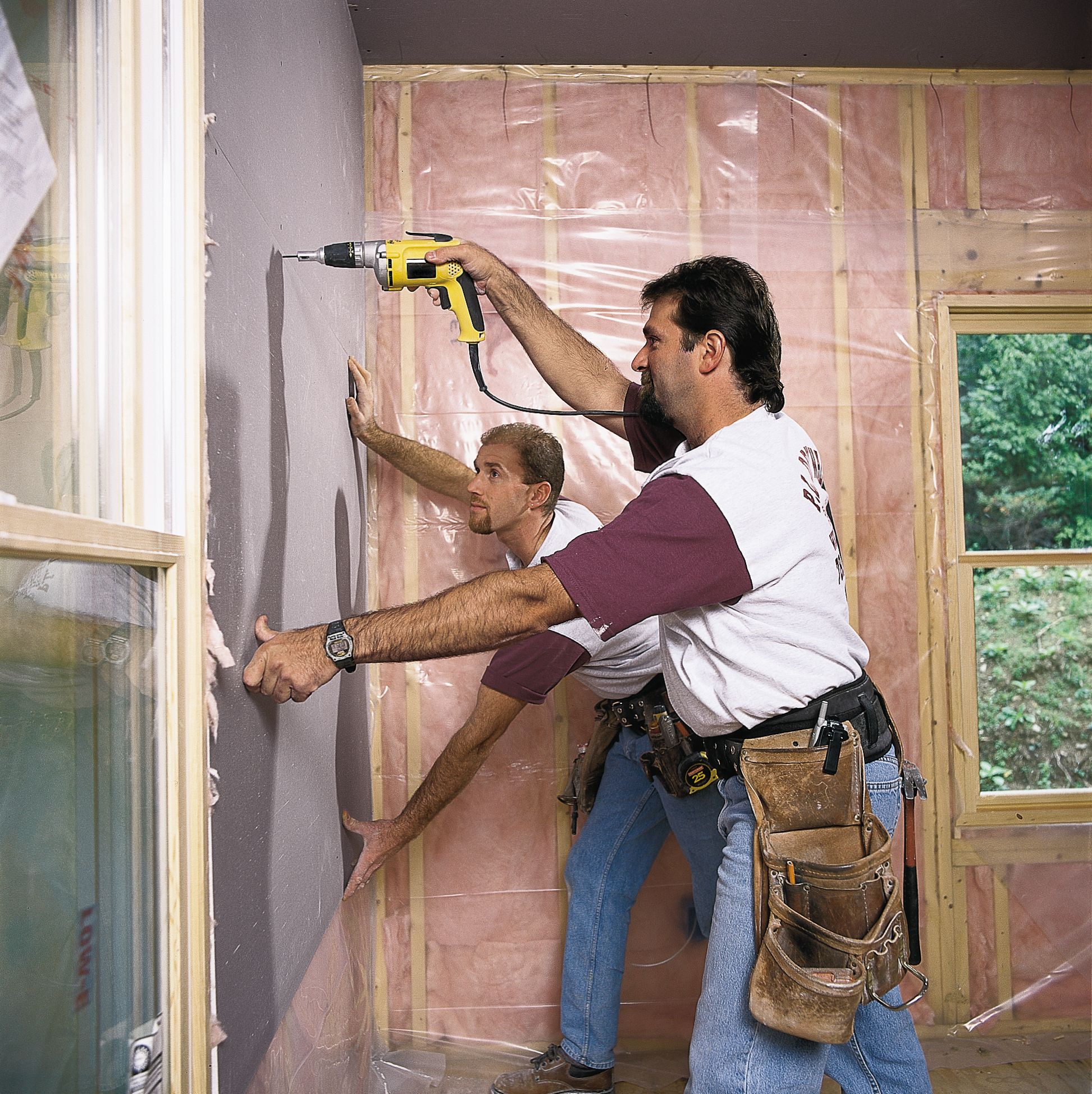Project details
Skill
Cost
Estimated Time
Hanging drywall is typically best left to the pros, but you may be able to tackle it yourself if you’re handy with home construction projects. You’ll need to use the correct screw length, off-set panels so seams don’t line up, and make sure wires and pipes aren’t in a position to be punctured. We’ll walk you through how to hang drywall step by step, including what you’ll need and how to troubleshoot common issues. Note that you’ll need someone to assist you with certain parts of the process, as drywall sheets are heavy to lift overhead.
Drywall Types and Sizes
A successful project starts with choosing the correct drywall for your project. Let’s review the types.
Standard Drywall
Standard drywall, also called gypsum board or wallboard, is the most common type used in residential construction. It typically comes in 4-by-8-foot sheets and is available in different thicknesses, including the following:
- 1/4-inch: This size is best for covering existing drywall or creating curved surfaces.
- 3/8-inch: This is a lightweight option for covering existing drywall.
- 1/2-inch: This is the standard thickness for walls and ceilings with studs 16 inches apart.
- 5/8-inch: This is a thicker option for ceilings or walls with studs 24 inches apart, also used for fire-resistant installations.
Specialty Drywall Options
For specific applications or environments, consider these specialty drywall options:
- Moisture-resistant (green board): Ideal for bathrooms and other high-humidity areas
- Fire-resistant (Type X): Required for garage ceilings and walls adjacent to living spaces
- Soundproof: Designed to reduce noise transmission between rooms
- Abuse-resistant: More durable and less likely to dent or develop holes
- Flexible: Thin panels that can be bent to cover curved surfaces
When choosing drywall, think about your project needs and installation environment. For most residential applications, 1/2 inch standard drywall is sufficient for walls, while 5/8 inch is often preferred for ceilings to prevent sagging.
Essential Tools for Hanging Drywall
Start by gathering the necessary tools. Here’s a list of what you’ll need:
Cutting Tools
- Utility knife with extra blades
- Drywall saw
- Keyhole saw or jab saw
- Rotary cut-out tool (optional but highly recommended)
Fastening Tools
- Drywall screw gun or drill with a drywall bit
- Hammer
- T-square
- Drywall lifter (for ceiling installation)
Measuring and Marking Tools
- Tape measure
- Pencil
- Chalk line
- Straightedge or level
Finishing Tools
- Drywall screws
- Joint compound
- Drywall tape
- Sandpaper
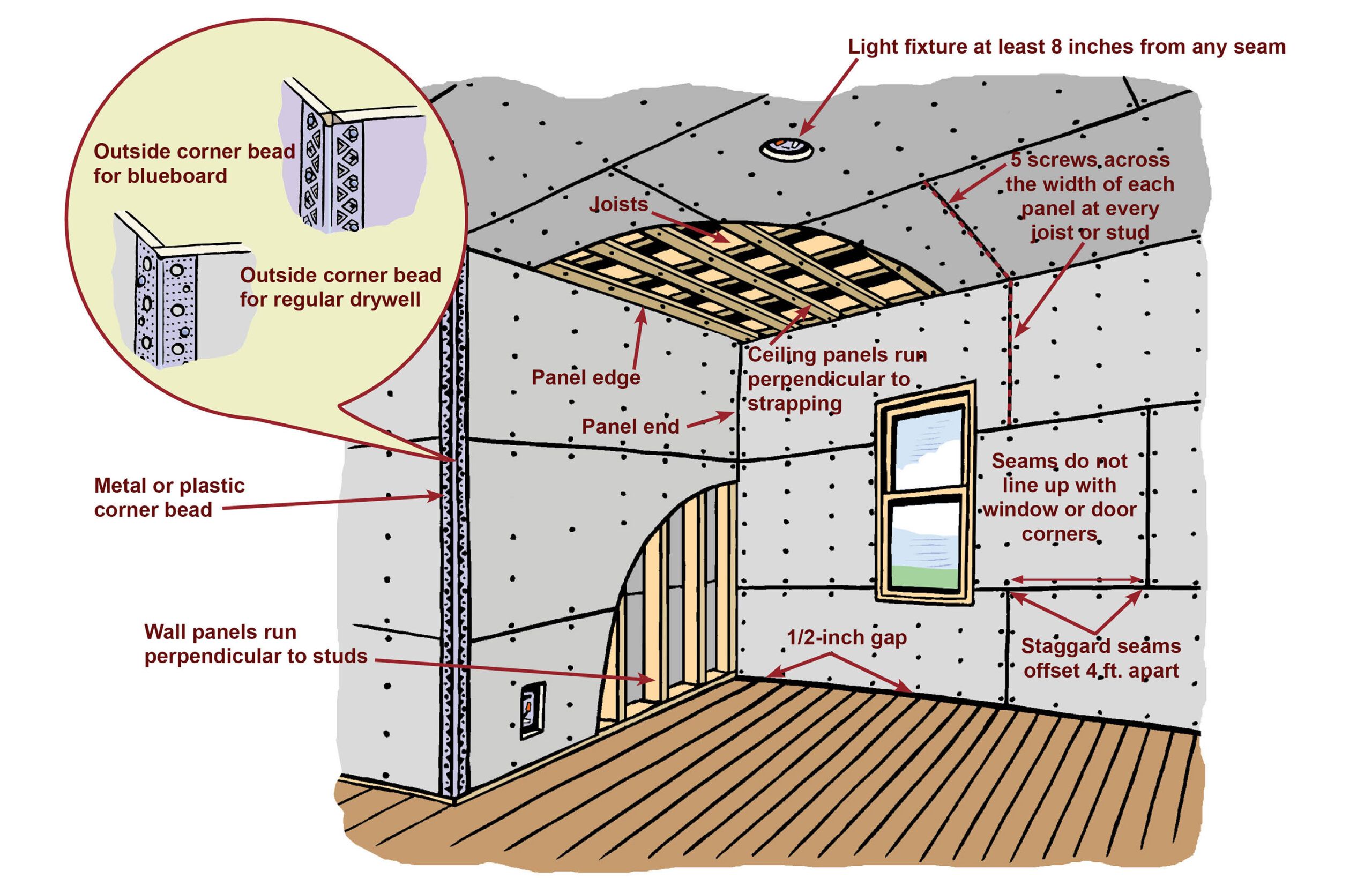
How Can You Prepare Your Space for Drywall Installation?
Follow the tips below to prep your space for drywall. Take special care when working with electrical wiring.
Checking for Electrical and Plumbing Issues
Before covering your walls, address any electrical or plumbing concerns, such as the following:
- Confirm all electrical wires are properly secured and protected from potential screw or nail punctures.
- Check that all plumbing is in good condition and free from leaks.
- Install electrical boxes for outlets, switches, and fixtures, making sure they’re flush with the planned drywall surface.
- Mark the locations of studs, joists, and any obstacles you’ll need to work around.
Ensuring Proper Framing
The quality of your drywall installation depends heavily on the condition of the framing beneath. Check the following before beginning your project:
- Inspect all studs and joists to ensure they’re straight and properly aligned.
- Add blocking between studs where needed to support drywall edges.
- Check that all framing members are dry and free from rot or damage.
- Verify that the spacing between studs or joists is consistent (typically 16 or 24 inches on center).
Planning Your Drywall Layout
A well-planned layout minimizes waste, reduces the number of seams, and makes the finishing process more manageable.
Calculating Materials
Here’s how to measure how much drywall you need:
- Measure the total square footage of the walls and ceiling.
- Divide the total square footage by 32 (the square footage of a standard 4-by-8-foot sheet).
- Add one or two extra sheets per room to account for waste and cutting mistakes.
Determining Panel Orientation
Decide whether to hang drywall horizontally or vertically. We recommend horizontal installation for walls. This reduces the number of seams and makes them less noticeable. Vertical installation is better for particularly tall walls or when working alone.
Plan your layout to stagger seams between rows, avoid seams at the corners of doors and windows, and minimize small pieces and odd cuts.
Step-by-Step Guide To Hanging Ceiling Drywall
Once you have the right materials and someone to help you with the heavy lifting, you’re ready to begin.
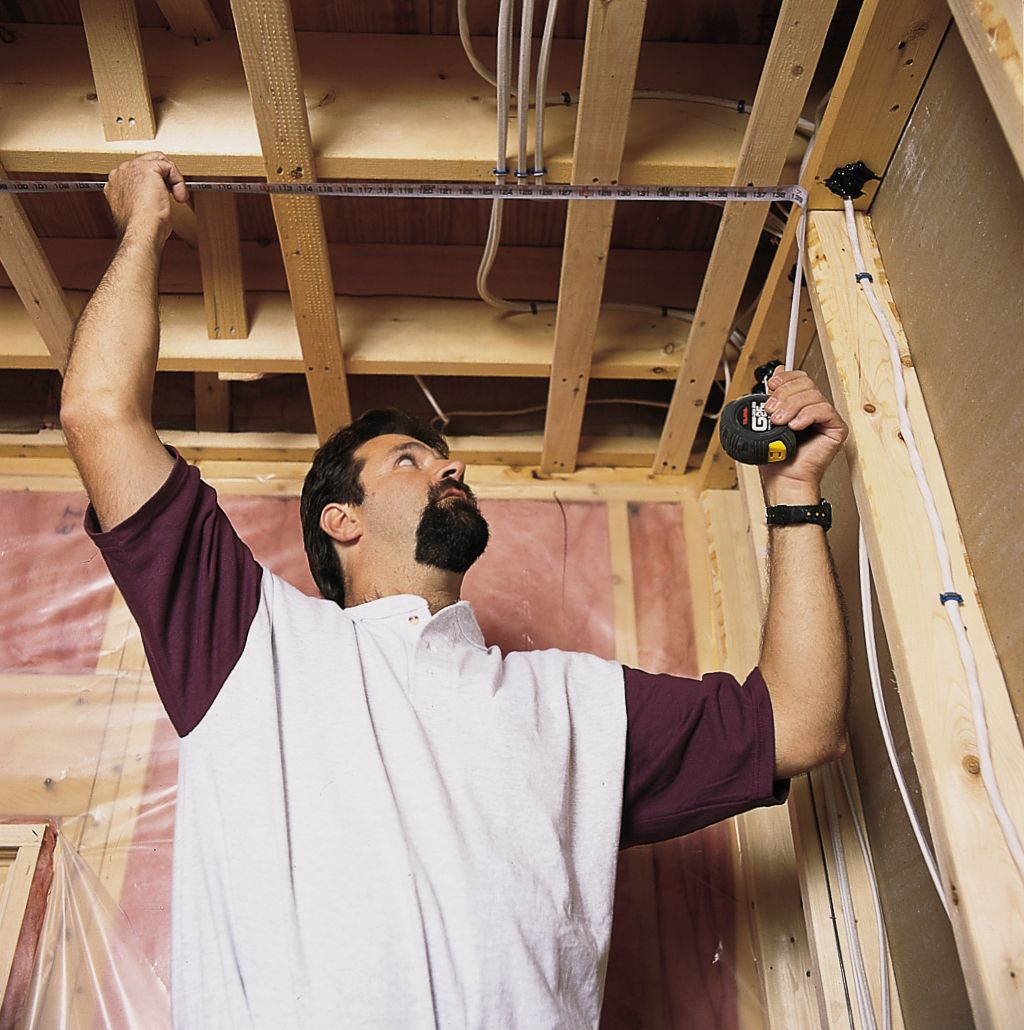
1. Measure and Cut Drywall for the Ceiling
To determine where the first panel’s end will land, measure out from a corner, perpendicular to the strapping, or the joists.
If the panel doesn’t span the entire ceiling, its end must land on the center of a strapping piece or joist. If it doesn’t, measure to the center of the farthest support piece the panel will overlap. Transfer that measurement to the edge of the first panel and mark it.
Hook a T-square on the panel and place it alongside the mark. Score through the paper on the front with a utility knife, using the T-square as a guide. Stand the panel on the edge and snap the waste part of it away from the score line. Cut through the paper backing to remove the waste.
To help locate where screws will go around the room, mark the top plate at all locations where strapping or joists intersect the wall.
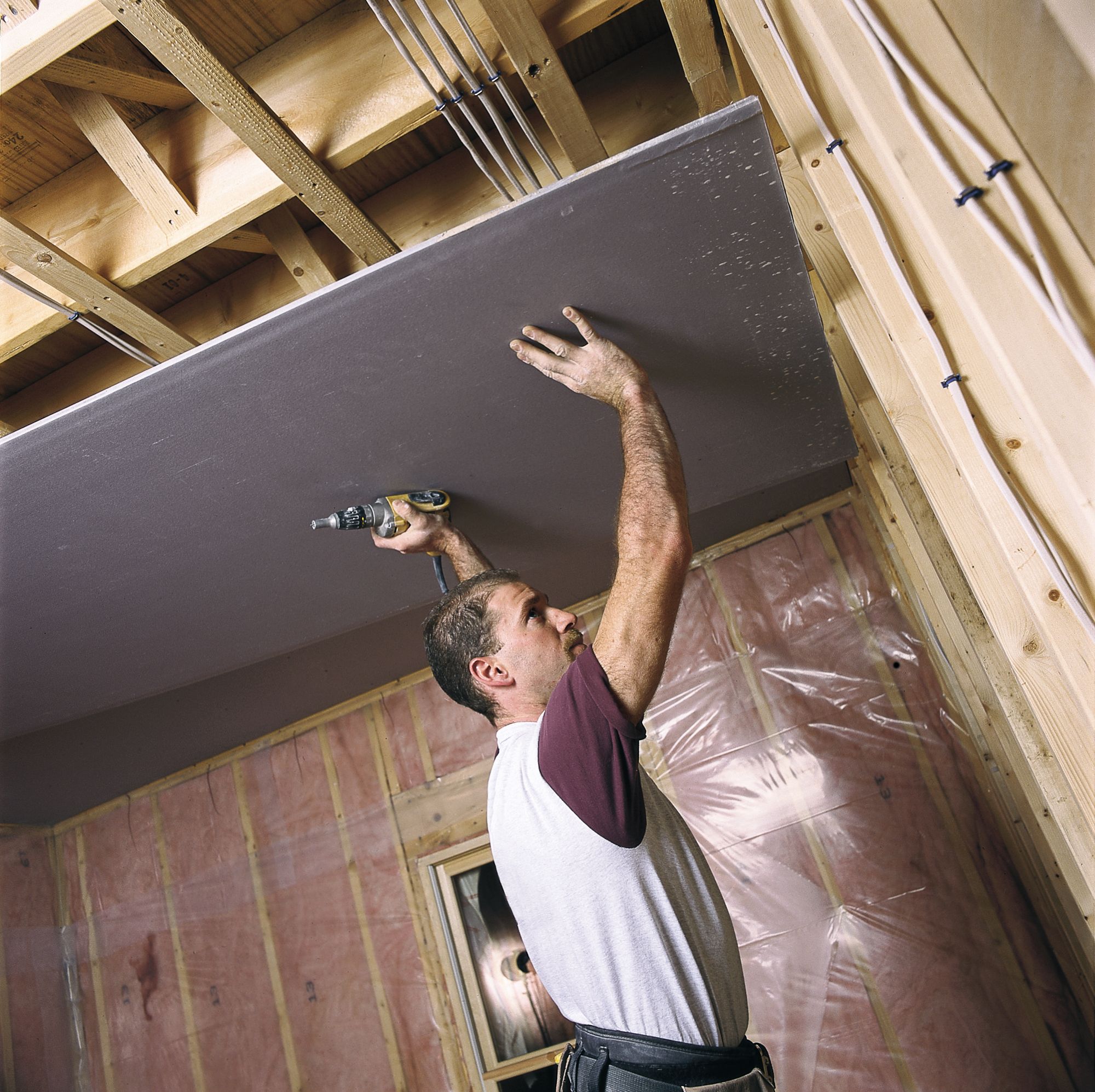
2. Cover the Ceiling
With an assistant, hoist the first panel into one corner of the ceiling. The edges should be perpendicular to strapping or joists, and one end should be tight to the wall.
As the assistant holds the panel, drive five screws, evenly spaced, in a line across the panel’s width and into the joist or strapping closest to the middle of the panel.
Use the marks on the top plate to help align the screws. Keep screws at least 1/2 inch from all edges. Drive the screwheads slightly below the surface of the paper but not so deeply that they break through.
Repeat this five-screw line at each joist or piece of strapping.
Continue the row in same fashion until reaching the opposite wall. Start the next row, making sure all end joints offset the panels in the first row by at least four feet.
Tip: Add a screw next to any screw head that breaks the paper.
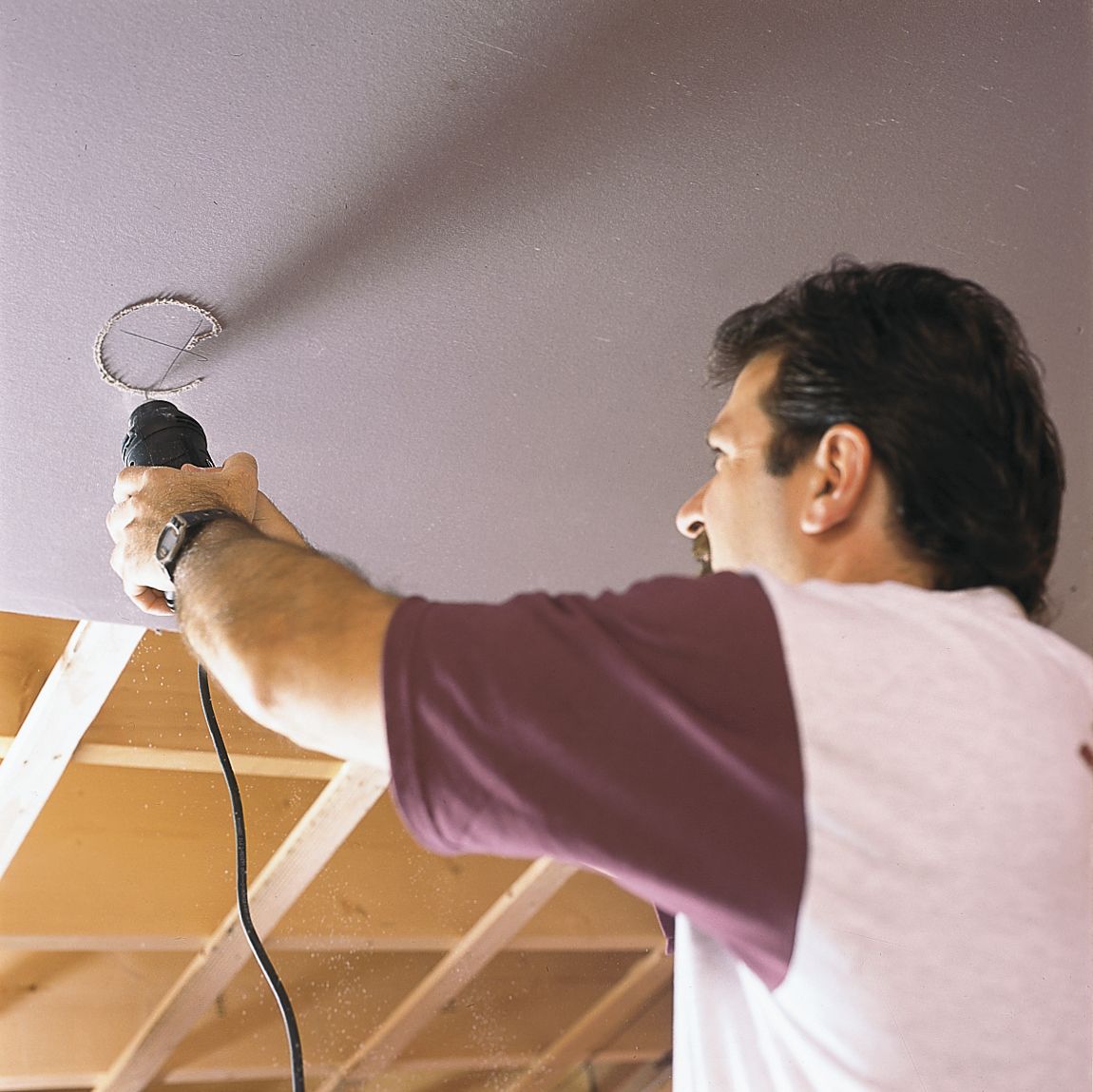
3. Using a Rotary Cut-Off Tool
Before installing a sheet of drywall over the electrical box of a ceiling fixture, measure from the center of the box to the near end of the last panel installed. Mark that panel end where the tape measure meets it and record the distance.
Cover the box with another panel, and attach it. Don’t drive screws any closer to the box than 24 inches.
From the mark on the last installed panel, measure out onto the new panel the same number of inches recorded previously, and mark the spot with an X.
Plunge the bit of a rotary cut-out tool into the center of the X. Move the tool outward until the bit strikes the inside of the junction box, then withdraw it and plunge it back into the panel next to the outside of the box. Hold the bit against the box and move the tool counterclockwise around its perimeter. Once the cutout is finished, drive the remaining screws into the panel.
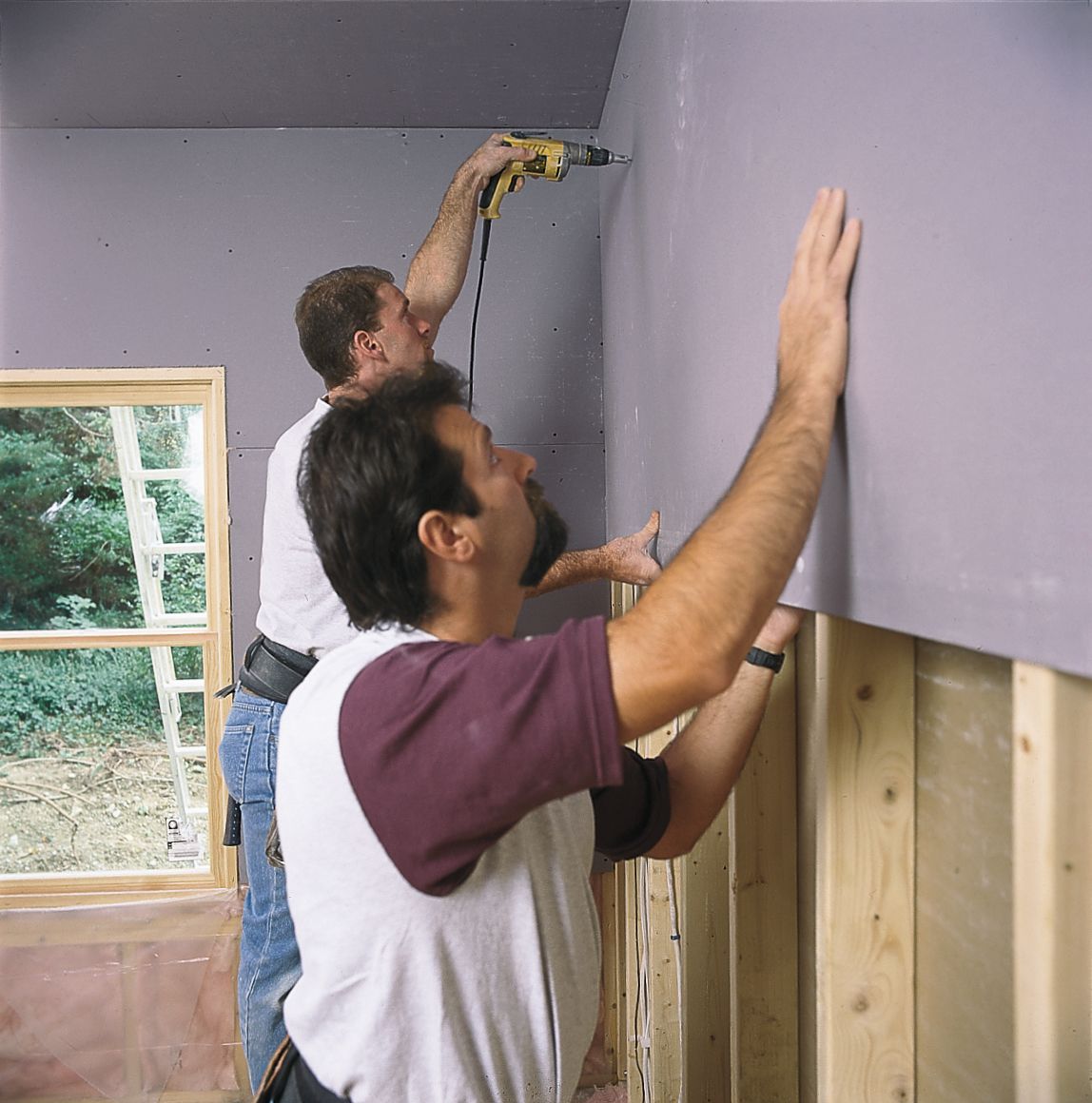
4. Covering the Wall
Mark all the stud locations on the adjoining ceiling panels. Use a tape measure to ensure the first panel’s end will land in the center of a stud; if it won’t, cut the panel.
With a helper, hold the panel against the studs so that one edge butts against the ceiling panel and one end fits snugly against the abutting wall.
Following the stud marks on the ceiling, drive a line of five screws through the drywall and into each stud. Start screwing into a stud close to the middle of the panel and work outward.
Continue hanging panels along the top of the wall, right over any window and door openings. (The excess will be trimmed later). Make sure no seams line up with a door or window corner. Don’t fasten panels to the framing around the openings yet.
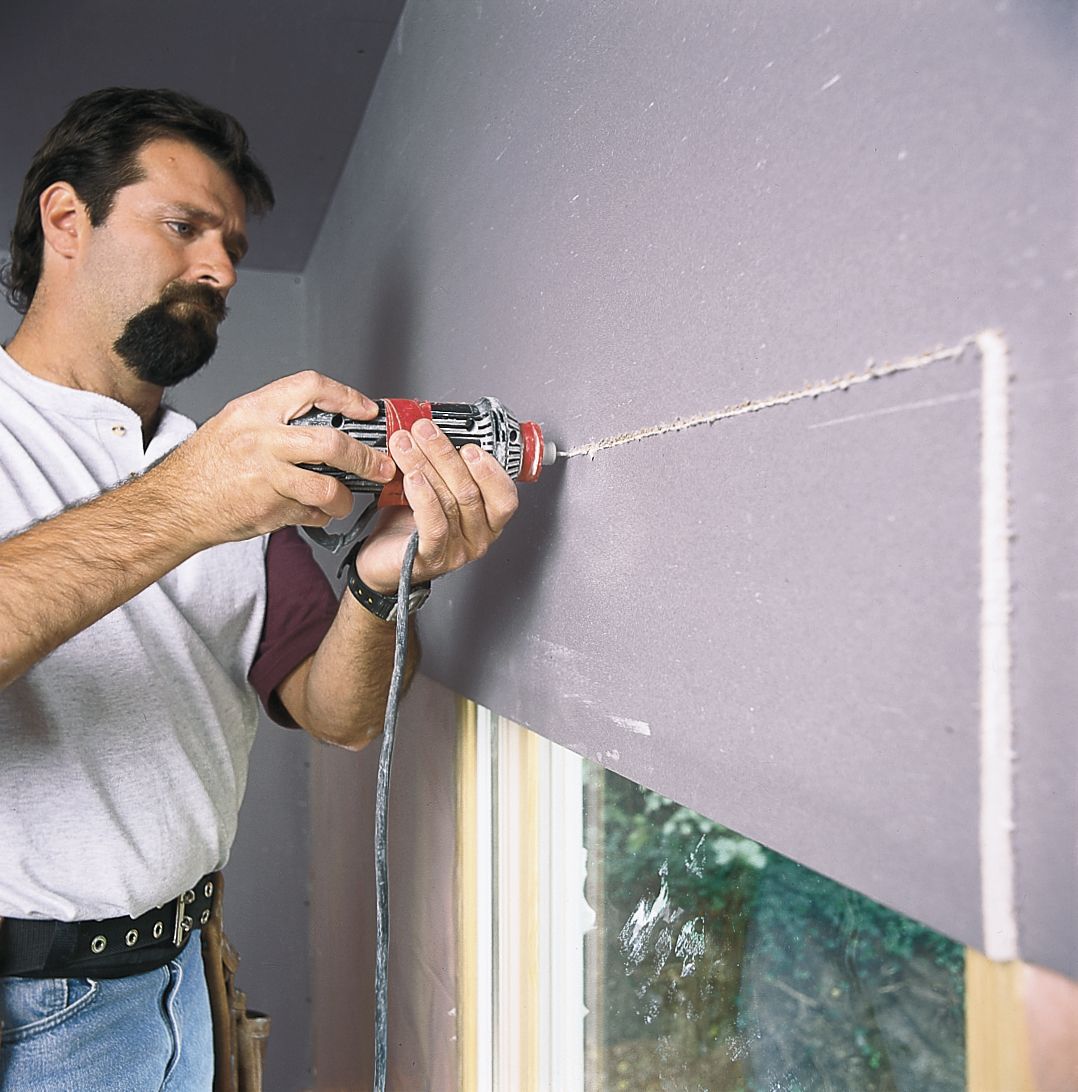
5. Trimming Around Doors and Windows
Install the next row of panels, butting the edges tightly together. (On the bottom row, use a drywall lifter to pry the panel one-half-inch up from the floor to allow for the framing’s shrinkage). As on the ceiling, offset the end joints from those in the previous row by at least four feet.
Hang panels over the bottoms of the window openings, making sure the seams don’t line up with the corners. Don’t screw panels to the framing around the openings yet.
Cut out the switch and outlet boxes following the same procedure as with the ceiling boxes as above. Mark the box locations before covering them with drywall, taking care not to drive any screws closer to each box than 24 inches. Cut holes for the boxes with a rotary cut-off tool, then drive any remaining screws.
With a cut-out tool or drywall saw, trim any ends and edges that project into window or doorway openings flush with the face of the innermost studs. Then screw the panel to the framing.

6. Making Inside and Outside Corners
At inside corners, butt the end of one panel against the face of the panel on the adjoining wall.
For outside corners, install the first panel so its end is flush with the studs on the adjoining wall. Overlap this exposed end with the panel on the adjoining wall so that the corner is completely encased in drywall. (With blue board, the panel ends do not overlap at outside corners. Their ends land flush with the corner of the stud. This void will be filled later with plaster.)
Cover outside corners with a metal corner bead, cut to the height of the wall. Trim each end to a 45-degree point and place the bead’s legs over the adjoining panel. Fasten the bead with one-and-one-half-inch drywall nails, hammered every 10 inches through the perforations in each leg so that the legs are tight to the wall and the corner is not distorted in any way. Do the same on the adjoining wall.
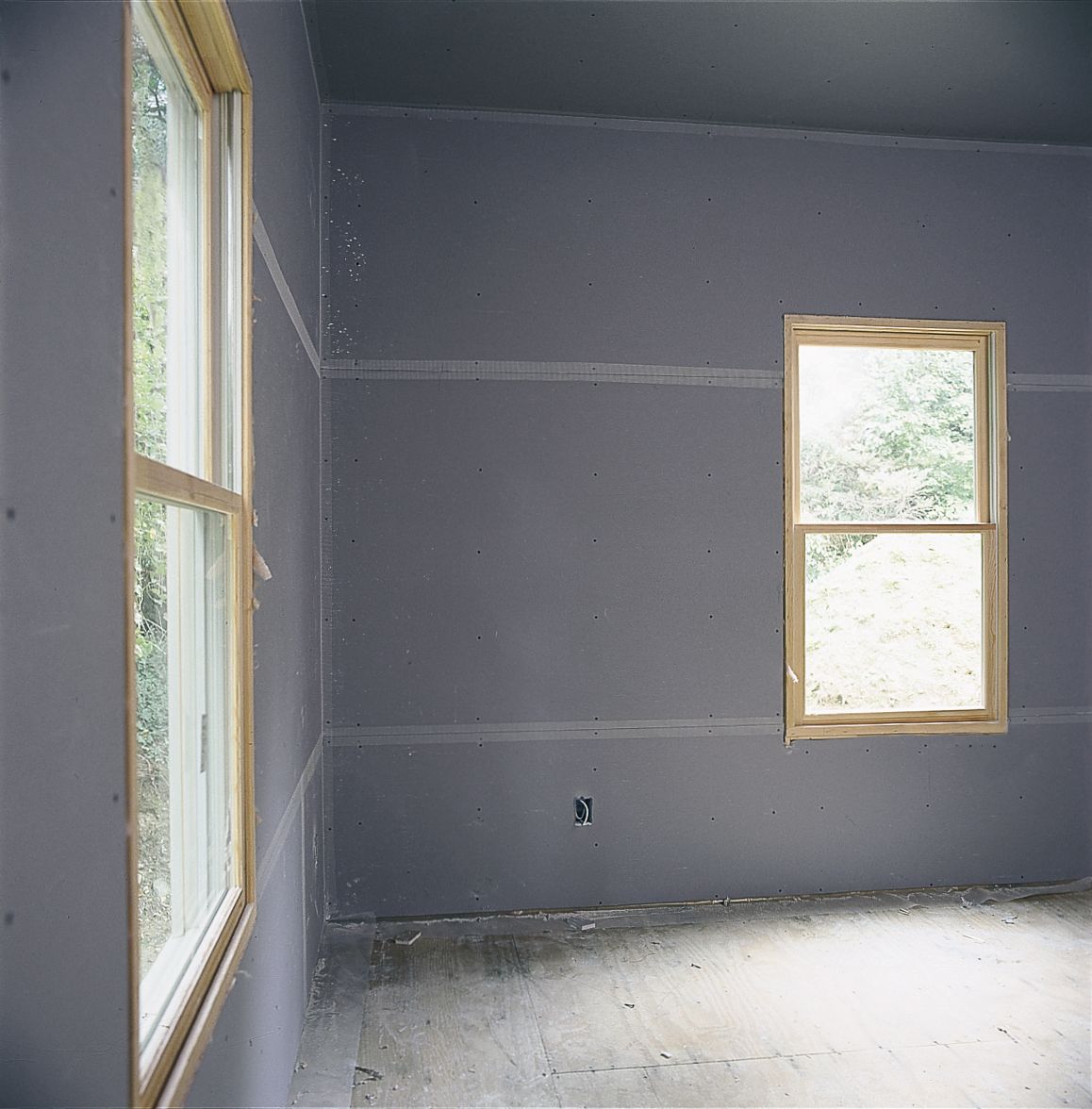
7. Completing Final Touches
After all the drywall has been installed, check for protruding screw heads. If you find any, carefully drive them in slightly below the surface of the drywall panel.
Also, look for screws that were driven too deeply and ripped into the paper face. Add a second screw next to any screw that has broken through the paper.
Sweep the floor clean, and remove any debris. The room is now ready for drywall finishing.
Drywall Taping and Finishing Basics
Once you’ve hung all your drywall, the next step is taping and finishing the joints. We have a full guide on how to finish drywall, but here’s a brief overview:
- Apply joint compound to all seams and corners.
- Embed paper tape into the wet compound, smoothing out any bubbles.
- Apply additional layers of compound, feathering out each layer to blend with the wall.
- Sand between coats for a smooth finish.
- Apply a final skim coat if needed.
Addressing Common Drywall Challenges
Even with careful planning, you may have some challenges installing your drywall. Here’s how to handle some common issues.
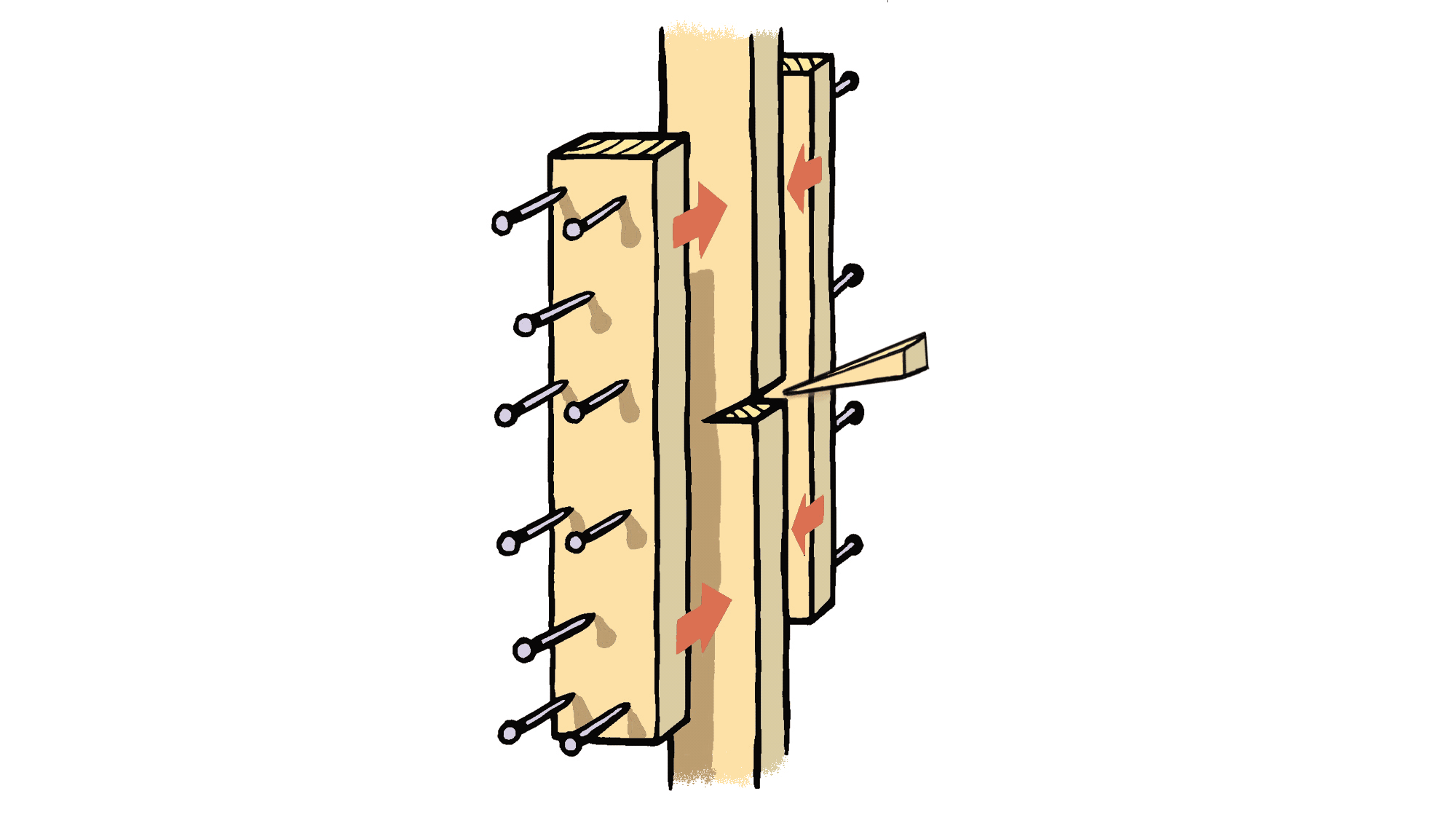
Dealing With Uneven Studs
Uneven studs can create bumps or dips in your finished wall. Here’s how to fix this:
- Use a long straightedge to identify problem areas.
- For studs that bow outward, use a power planer to shave them down.
- For recessed studs, use shims to align them.
Managing Heavy Panels
Large drywall sheets can be hard to handle, especially when working alone. Try these tips:
- Use a drywall lifter for ceiling panels.
- For walls, rest one edge on a two-by-four-inch piece of scrap to help position the panel.
- Consider using lighter three-eighths-an-inch panels to cover existing drywall.
Cutting Around Obstacles
Installing drywall around electrical boxes, pipes, and other obstacles requires attention to detail. Carefully measure the location of the obstacle, and transfer the measurements to your drywall panel. Use a rotary cut-out tool or keyhole saw for clean, accurate cuts. Always cut holes slightly larger than needed to allow for adjustments.
How to Avoid Common Drywall Mistakes
Steer clear of these common errors for a high-quality finish:
- Don’t align panel joints with door or window corners, as this can lead to cracks.
- Avoid leaving small strips of drywall at corners or edges, which are prone to cracking.
- Don’t force drywall into place. Trim it down if it doesn’t fit.
- Make sure all electrical boxes are flush with the drywall surface before cutting holes.
Follow these tips and pay close attention to detail to create a solid foundation for the taping and finishing, which will result in smooth, professional-looking walls and ceilings.
Time and Cost Estimates for DIY Drywall Installation
The time and cost of a DIY drywall installation can vary widely depending on the size of your project and your level of experience. Here’s a rough estimate:
- Time: For a 12×16 foot room, expect to spend several hours hanging drywall, plus additional time for taping and finishing.
- Cost: A 4-by-8-square-foot drywall sheet typically costs $10–$15 each, per Angi. Factor in additional costs for tools, screws, tape, and joint compound.
While DIY installation can save on labor costs, weigh the time investment against the potential savings.
When To Call a Professional Drywall Installer
While hanging drywall is a manageable DIY project for some homeowners, there are situations where it’s best to call in a professional, such as the following:
- Large or complex projects that require extensive experience
- High ceilings or difficult-to-reach areas
- When you’re short on time
- When you’re not confident in your ability to achieve a professional-looking result
- Specialty applications such as soundproofing or fire-resistant installations
Professional installers have the experience and tools to finish the job quickly and expertly.
Our Conclusion
Use your judgment about whether hanging drywall is a project you have the skill level to attempt on your own. Remember to focus on safety, take your time with measurements and cuts, and enlist assistance when needed throughout the installation.
